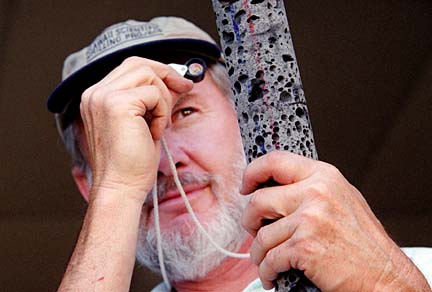Advertisement - Click to support our sponsors.


Scientists dig
for clues to
volcano’s origins
Lava evidence suggests
By Helen Altonn
Koolau volcano formed
differently from others
in the island chain
Star-BulletinScientists in three countries will analyze rocks from a 2,227-foot-deep hole drilled in Kalihi Valley in hopes of better understanding the Earth's history and the origin of volcanoes.
"Surprisingly, lavas in the volcano in Honolulu are unlike any other volcano in Hawaii or anywhere in the world," said Michael Garcia, University of Hawaii geology and geophysics professor.
Garcia is one of two principal investigators for the international drilling project, conducted the during the past six weeks on Koolau volcano. The other is Fred Frey, Massachusetts Institute of Technology geochemist.

Scientists expect lavas from the Koolau volcano -- formed than than 2 million years ago -- to tell them more about how the Hawaiian Islands formed.Although Hawaii's hot-spot volcanoes are the most studied in the world, much remains puzzling about their origin, Garcia said.
It's believed plumes of magma, or molten rock, rose from a hot spot in the Earth's mantle to create the chain of islands up to Midway and Wake, which moved northward on the sea floor's Pacific Plate.
But Koolau lavas have a distinctive high silica content, suggesting they formed in a different fashion, Garcia said.
Much lower silica content in volcanoes such as Kilauea and Mauna Loa "can easily be explained by melting of the Earth's mantle," he said.
He said, however, the chemistry of Koolau lavas indicates "that the ocean crust must be involved in this heat machine."

This theory proposes that oceanic crust is forced into the Earth's mantle at trenches like the Marianas Trench near Guam, he said. The crust sinks about 1,900 miles to the Earth's core, where it is reheated to form hot spots."The idea is that ocean crust gets recycled all the way down to the core and is remelted and brought to the surface," Garcia said. "It's a wild idea."
The crust's journey is believed to take about 2 billion years.
Garcia said the Koolau rock samples offer a good opportunity to establish the volcano's age and magnetic history.
It is at least 2 million years old, and possibly older, he said. He is working with Japanese scientists who are studying the other side of the volcano that has collapsed into the ocean; they've dated rocks at 3 million to 5 million years old.
Scientists from Germany and Japan are investigating Koolau volcano with researchers from UH and MIT, Caltech, the University of California-Berkeley, Woods Hole Oceanographic Institution and the Carnegie Institute in Washington.
The National Science Foundation provided $100,000 for the program and each institution contributed $10,000 for the project, Garcia said.
A new scientific drilling rig was brought from the mainland especially for the project, which piggybacked on a Honolulu Board of Water Supply drill hole in the Kalihi Shaft station.
Two mainland drillers came with the rig and Kiki Kama, a driller from the Big Island, also participated, Garcia said. "They are the heroes of the project."
The specially designed diamond-coring, wireline rig drilled about 100 feet daily, deepening the 1,150-foot water well to 2,227 feet to recover cores 2.4 inches wide.
Scientists knew the lavas were unique from those exposed in the Koolau Mountains, but those are compromised by tropical weathering, Garcia said. The underground rock is pristine because it has been kept cool and wet.
Because the drill site is in a residential area, scientists went to neighborhood meetings to describe the project's importance and they operated the rig only from 8 a.m. to 5 p.m. "to be good neighbors," Garcia said.
The neighbors showed up at the fence around the site to chat after the rig was turned off at 5 p.m.
"That was the neat thing about the project," he said. "People were curious. They wanted to know."
Garcia also praised Chester Lao, chief geologist for the Board of Water Supply, for his support. "It's his scientific curiosity about the islands that helped promote cooperation."
Garcia and graduate student Eric Haskins are cutting samples to examine the interior, then drying them and taking digital photos for a database shared with scientists around the world.
Descriptions and photos are sent to the Intercontinental Drilling Program in Germany and posted on the Web: http://icdp.gfz-potsdam.de/html/koolau/news.html.
Frey is expected here next month to look at the rocks and help select samples for analysis by other researchers, Garcia said.
Garcia and others in the Koolau project were involved the past few years in drilling a hole about three miles deep on Mauna Kea to answer questions about the Earth's interior mechanisms. UH geochemist Don Thomas conducted that project and helped to organize the Koolau venture.
This was the first time a coring project was done to recover lavas from Koolau volcano, he said.
"We think of these volcanoes as made of different components, like making stew. Different components of the mantle make it."